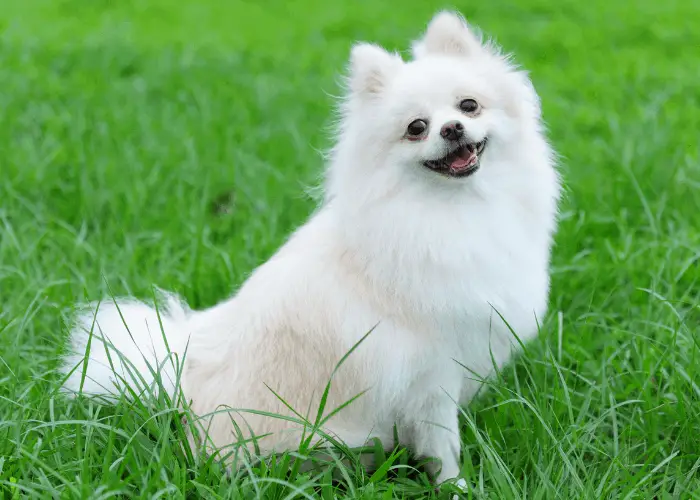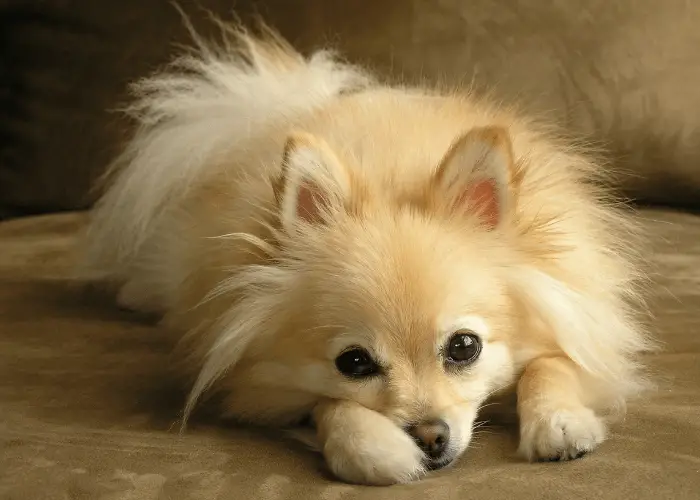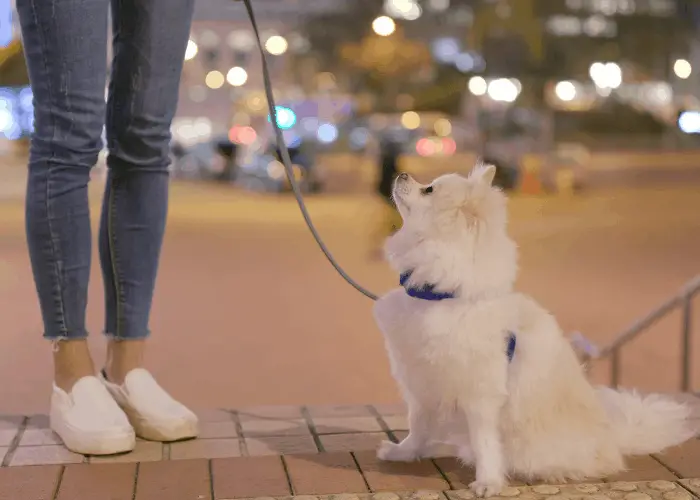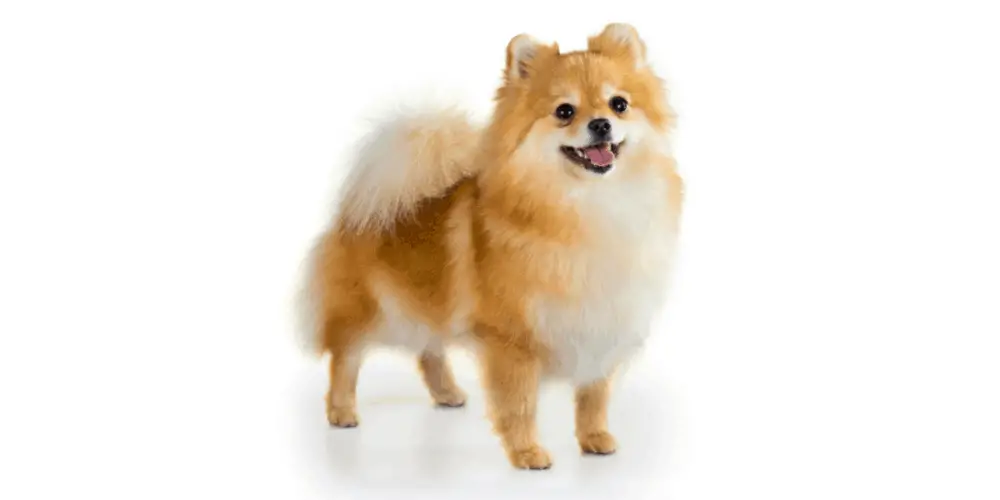- Name: Pomeranian
- Other names: Deutsche Spitze, Zwergspitz, Spitz nain, Spitz enano, Pom, Zwers, Pompom
- Origin: Germany
- Size Type: Small dog breeds
- Breed Group: Toy dog breeds (AKC)
- Life span: 12 -16 years
- Temperament: Active, Playful, Intelligent, Sociable, Friendly, Extroverted
-
Height: 8 – 12 inches
-
Weight: 3 – 7 pounds
-
Colors: Black, Tan, Brown, White, Orange, Grey-shaded
-
Puppy Price: $1k – $3k USD
Breed Overview

Also known as the Dwarf Spitz, Pomeranians are small dogs selectively bred from smaller German Spitz to create the small, cute and cuddly breed known today.
Not only are Pomeranians among the most popular dogs (they are one of the top 15 breeds in America), but most doggy fashion is made for small Ewok-like breeds like them.
While Pomeranians might seem like divas due to their long hair and lively temperaments, these dogs are actually fairly easy to care for if you take a right disciplinary actions, and they love learning tricks and cuddling up when it’s nap time.
- Good with Kids: ★★★★★
- Cat Friendly: ★★★★★
- Dog Friendly: ★★★★★
- Trainability: ★★★★★
- Shedding: ★★★★★
- Watchdog: ★★★★★
- Intelligence: ★★★★★
- Grooming: ★★★★★
- Popularity: ★★★★★
- Adaptability: ★★★★★
- Hypoallergenic: No
Body Type

Pomeranians are toy dogs, but their small stature belies a lively personality. These German dogs are very compact, but they are still durable and can play roughly with other dogs and humans.
Most breeds will only be about five to eleven inches in height at the withers, and they should only weigh about 4 to 8 pounds. However, a few types, such as the Teacup Pomeranian, are far below these averages.
Aside from their double coat, one of the most recognizable features is their high tail. Their tails are often well-plumed with a lot of fluff, and their curve upwards and rest on the back part of the spine.
However, don’t be fooled. Their tails look thick due to the fur, but they are actually very thin, so be careful when touching them. The tail can be easily injured, but you shouldn’t have a problem with this.
When it comes to body dimensions, you’ll notice just how compact Pomeranians really are. Their deep chest is fairly slim, the backs are sturdy but short, and the loin and croup areas are typically short and broad.
Though they have short legs, they don’t look stumpy because they are in proportion to the Pomeranian’s overall size.
Most Pomeranians have a wedge-shaped head with a short and defined muzzle. The teeth are small and delicate and meet in a scissors formation. Their eyes are also dark and alert, which makes them seem even more responsive.
Coat

The coat is definitely what distinguishes the Pomeranian from other toy dogs. Aside from being long and giving the Pomeranian more depth, their fur is double coated.
The undercoat is the best for petting because it is thick, short, and definitely soft.
The outercoat is long and straight and relatively harsh. However, the outercoat isn’t coarse or as harsh as other dogs. Some types lack harsher fur. You might think that grooming is difficult due to the thick hair, but you would be mistaken.
If you are diligent and brush your dog at least once every one or two days, then the Pomeranian shouldn’t experience any major tangling or knotting.
However, tangling does become more common when the Pomeranian is shedding its undercoat, which happens twice a year. When brushing, pay special attention to the neck and chest because the fur is longer in these areas.
The coats come in a variety of patterns and colors. The earliest Pomeranians were white and black.
While still common, these aren’t as common as orange, brown, and red coats. There are also tan and blue coats. Breeders are constantly trying to create different coat colors to satisfy the public demand.
CHECK OUT: Most Popular Pomeranian who ever lived.
Temperament

The Pomeranian has some good and bad personality traits, but you can easily mitigate the bad with proper knowledge and training. The best thing about Pomeranians is that they are smart dogs. They are very responsive and able to learn new tricks with ease.
This can easily extend into adulthood, where they will remain responsive, but teaching them tricks can be a little harder in the later years. They are incredibly proud and extroverted. They love being praised and acting as the center of attention, but they tend to forget their size and try to establish dominance around other dogs and people quickly.
In fact, many Pomeranians suffer from separation anxiety when people leave the house if they believe they are the alpha since no one is supposed to leave without the alpha’s permission. Training should be firm but gentle. It should also begin when the Pomeranian is a puppy to ensure that the dog’s pride doesn’t become intrusive.
Pomeranians are very protective of their territory and companions. While they will be quite friendly once introduced to a new person or dog or other pets like cats, they will initially bark and growl as a protective measure. This makes Pomeranians great guard dogs because they will bark at the slightest sound, but it can get annoying since you will have to properly introduce new friends to your dog before they calm down.
Be sure to start training as soon as possible to ensure that the Pomeranian’s negative aspects are subdued, which will make it much easier to live with the new dog. Properly trained Pomeranians will be very playful, lively and will love a good cuddling and petting session.
Pomeranian Pros and Cons Video
Important Tips:
First of all, no matter what the breeder or shelter was feeding the Pomeranian, it’s important to make a slow change to another type of food. Immediately changing from one food to another can have significant health effects on the dog due to its small size.
It would help if you made small changes every week for a month before giving your Pomeranian the food of your choice.
Calcium is essential for Pomeranians. Not only are their tiny bones susceptible to breaking, but their teeth are relatively small and brittle. A good amount of calcium will keep your Pomeranian strong and sturdy.
They need dog food that accounts for their unique metabolism. They will burn more energy than other similarly sized dogs when puppies, but their metabolism quickly changes as they grow into adulthood.
Be careful of dog foods with many fillers and carbohydrates because Pomeranians are fairly susceptible to diabetes.
Another interesting fact is that Pomeranians can be picky eaters. See what your dog likes, and then find suitable pet food for their unique tastes.
Pomeranians love vegetables, especially potatoes, carrots, spinach, and broccoli. Find pet foods with these vegetables to give them enough vitamins and minerals. However, be sure to avoid corn. High glucose levels can lead to health problems later in life.


